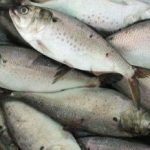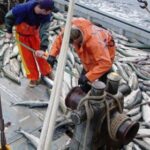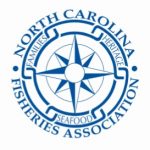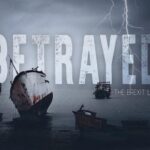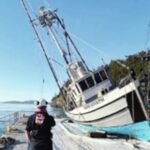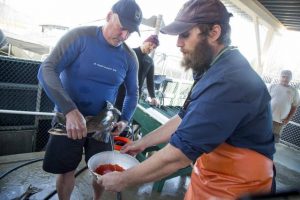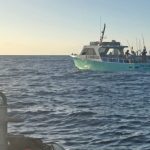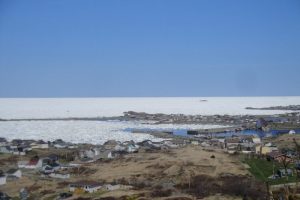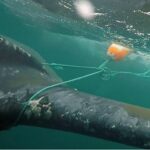Tag Archives: commercial crab fishermen
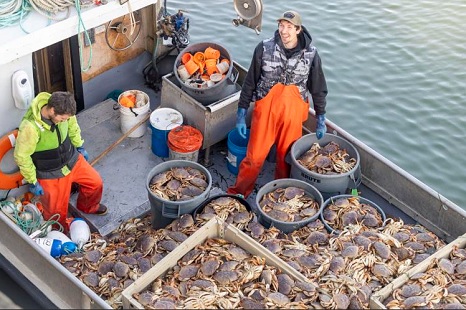
Willapa Bay crabbers deliver record haul
More than 1.5 million pounds of Dungeness crab have been caught by commercial fishermen in the bay this year, far exceeding previous annual landings records over the past 25 years. Despite a two-month delay in the 2022-2023 season that eventually began Feb. 1, the current commercial Dungeness landings are about 1.54 million pounds as of Monday, March 27, a roughly 23% increase over the previous record of 1.19 million pounds caught during the entire 2010-2011 season. Pinched by inflated fuel and expenses and a low price from processors, commercial crab fishermen would rather put this current season behind them as they prepare for the next fishery. “It’s been above average,” said commercial fishermen Ross Kary. “But with the crab price it’s still not the best year I’ve had. With the price of everything, expenses are really high. We were lucky to not go bankrupt.” Photos, >click to read< 20:20
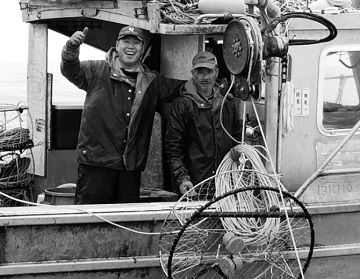
Reallocation: Fed changes to BC crab fishery could bankrupt some commercial fishermen
Commercial crab fishermen in British Columbia fear that changes to the way they can fish for Dungeness crab off the west coast of Vancouver Island could push some small, family operations out of business. This year however, crab fishermen like Jason Voong, 33, may not be able to harvest enough crabs to stay in business following changes announced by the federal government in December to reallocate half of the licenses available in the area to local First Nations. “I fully support, and the fishers support reconciliation, it’s just a process that’s wrong right now the way DFO has treated the commercial fleet and the five nations.” >click to read< 09:41
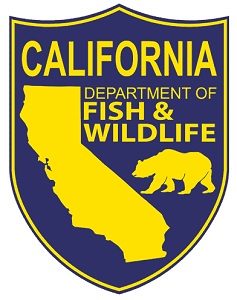
Commercial Dungeness Crab Fishing Violations on the Rise
Since December 9, 2021, there have been five cases out of Crescent City and two out of Eureka regarding possession of undersize crabs by commercial crab fishermen. The most common violation during this period has been commercial harvest of undersized crabs. Commercial Dungeness crab fishermen are expected to measure their entire catch and keep only crabs that are equal to or greater than 6 ¼ inches, which is slightly more than the required 5 ¾ width required of recreational crabbers. There is a provision in the law to authorize possession of no more than one percent of the catch to be undersize. In all seven cases, citations were written, the loads were seized and the proceeds from the sales of the crab were directed to the Wildlife Preservation Fund until the cases can be adjudicated in court. >click to read< 15:20
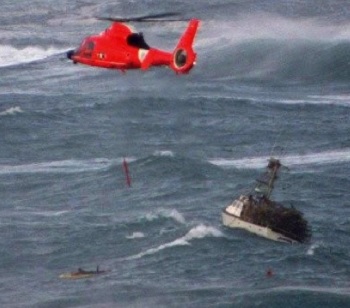
Crab Boat Sinks – Coast Guard Rescues Distressed Fishermen
A spokesperson for the U.S. Coast Guard confirmed this evening. that members of the agency “rescued three fisherman” this afternoon near Patricks Point State Park north of Trinidad but said he wasn’t able to provide more information until he had gathered more facts. photos, >click to read<– A crew of commercial crabbing fishermen were rescued by U.S. Coast Guard Sector Humboldt Bay today after their boat experienced engine failure in turbulent water off the coast of Agate Beach. video, >click to read< 06:58
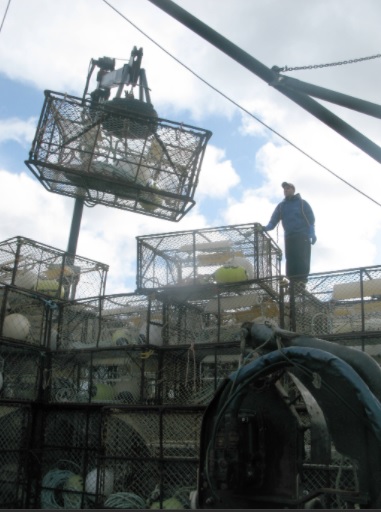
Bering Sea Crab harvests set: Kings still in decline, snow and Tanner see bump
Commercial fishermen will be allowed to harvest a total of 45 million pounds of snow crab from the Bering Sea waters this year, with 4.5 million of that set aside for Community Development Quota groups and the rest for individual fishing quota, or IFQ, holders. That’s about 34 percent larger than the limit last season, which was also an increase over the previous year. Bering Sea Crabbers Association Executive Director Jamie Goen said that’s good news for the fleet. However, members of the fleet also think that TAC could have been a lot higher had the National Marine Fisheries Service been able to conduct its regular surveys. >click to read< 08:29
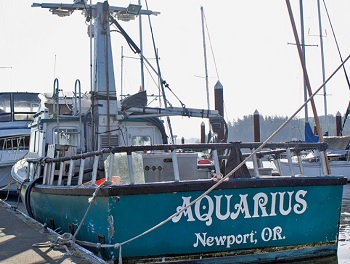
In Tribute – ‘Crabbing brings Florence’s Novelli family together’
Almost a year ago today I stepped onto The Aquarius for the first time. Amber and Kyle Novelli were taking me out on their crabbing boat so I could catch a glimpse into their everyday lives as commercial crabbers. Amber and I talked about the water and how dangerous getting out past the bar was; we talked about how unstable crabbing can be economically and how the weather really runs your whole life as a crabber. I asked her why she kept doing it with so much danger and uncertainty to face. She answered by telling me a story about a time they were out on the water fishing. It was early in the morning and, as she woke up, she wandered out to look at the ocean. That’s when she saw it,,, I listened to her and Kyle’s story of how they started fishing together,,, Victoria Sanchez, >click to read< 15:00
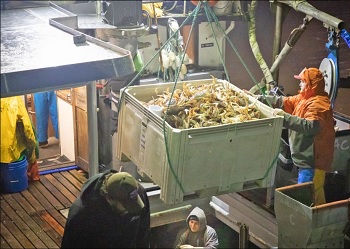
Crabbers brave ‘sloppy seas’ to start harvest
Fishing crews reported enduring ‘sloppy seas’ for most of the season so far. “It was a little rough,” said Paul Blaylock of the F/V Amanda C, upon delivering their first catch of the season on Jan. 2. “We got a little wet.” The weather has fishermen and processors hopeful for more favorable conditions in the coming days. “It’s been a struggle. The fishing windows are very narrow right now,” 11 photos, >click to read< 08:59
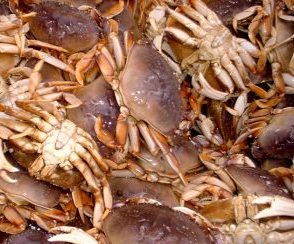
California crabbers concede 25 cents
Local commercial Dungeness crab fishermen return to their trade today but will receive 25 cents per pound less for their catch than when they started the season earlier this month. Following a meeting on Monday, crabbers in Brookings, Crescent City, Trinidad, Eureka and Fort Bragg agreed to resume fishing on Tuesday, said Rick Shepherd, president of the Del Norte Fisherman’s Marketing Association. Seafood buyers are now paying fishermen $2.50 per pound, Shepherd said. “We’re trying to hold that $2.75, but we don’t know how long we’d have to sit to do it,” he said. “There’s not much else we can do.” >click to read<11:07 

Fingers crossed there won’t be anything to be crabby about this season
With their pots stacked high and boat decks washed, commercial crab fishermen along the Central Coast are prepped for a season that is expected to start next Wednesday, on-time for the first time since 2014. And the getting could be good. “Ocean conditions over the past couple years, as the crabs that we’ll catch this year have matured, have been pretty good,” says Noah Oppenheim, executive director of the Pacific Coast Federation of Fishermen’s Associations in San Francisco. “It was good enough that we think the resources will be very healthy.” “Brutal,” “devastating,” “a disaster,” are all ways fishermen and heads of the industry have described the crab seasons of 2015 and 2016,,, click here to read the story 09:25
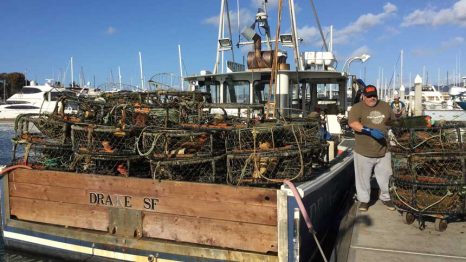
Fishing Community Tackles Trash in the Ocean
Fishing gear is not the biggest contributor to the “Great Pacific Garbage Patch” or other accumulations of trash in the ocean, but derelict gear left at sea after a fishing season does create problems. In California, the fishing community itself is creating a solution that improves the health of species and the environment, and the involvement and viability of local communities. There is typically no by-catch with pot fishing, said Andy Guiliano, a Dungeness crab fisherman from Emeryville, California. In Guiliano’s perspective, this makes the Dungeness crab fishery an environmentally friendly fishery. But Guiliano’s experience has tested this outlook. “The only Achilles’ heel is, inevitably, gear gets lost during the season,” Guiliano admitted — gear amounting to hundreds of crab pots as well as nets that can affect boat propellers and large whales. click here to read the story 08:42
Louisiana commercial crab fishermen will see conservation restrictions for next three years
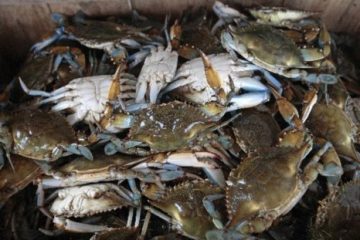 Louisiana took another step toward a commercial crabbing season Thursday after the Louisiana Wildlife and Fisheries Commission approved a proposal that would shut down crab fishing for 90 days over the next three years. Department of Wildlife and Fisheries crustacean biologist Jeff Marx told the commission Louisiana’s crab harvest is too high, and something needs to be done to protect the health of the fishery. “It’s not panic mode, but it is something we’re concerned about,” he said. Marx asked the commission to approve a department plan that would shut down all commercial crabbing for 30 days beginning the third Monday in February. The closure would be in effect in 2017, 2018 and 2019. Also restricted would be harvest of immature female crabs throughout the year, except for those that show signs of imminent molting. So-called “buster” crabs are important for the soft-shell-crab industry. Read the rest here 14:55
Louisiana took another step toward a commercial crabbing season Thursday after the Louisiana Wildlife and Fisheries Commission approved a proposal that would shut down crab fishing for 90 days over the next three years. Department of Wildlife and Fisheries crustacean biologist Jeff Marx told the commission Louisiana’s crab harvest is too high, and something needs to be done to protect the health of the fishery. “It’s not panic mode, but it is something we’re concerned about,” he said. Marx asked the commission to approve a department plan that would shut down all commercial crabbing for 30 days beginning the third Monday in February. The closure would be in effect in 2017, 2018 and 2019. Also restricted would be harvest of immature female crabs throughout the year, except for those that show signs of imminent molting. So-called “buster” crabs are important for the soft-shell-crab industry. Read the rest here 14:55
Despite delay, Dungeness maintain strong economic grip
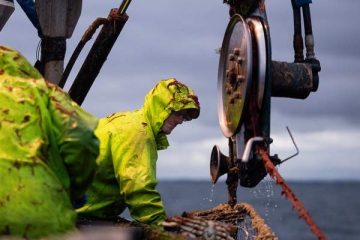 While some commercial crab fishermen are still trickling into ports in Oregon and Washington, the majority of commercial crabbing has slowed for the season as attention turns toward other fisheries. Those remaining are primarily doing so for the live crab market, which fetches top dollar. Oregon and Washington landings, The latest total for Oregon is 13.8 million pounds, according to the Oregon Department of Fish and Wildlife (ODFW) — a dramatic increase from the 8.2 million caught in 2014-15. The Port of Astoria has recorded 4.4 million pounds. Oregon landed 9.7 million pounds in January alone. In February 2.7 million pounds were recorded. The catch slowed to 700,000 in March and 440,0000 in April, respectively. Washington’s January catch also eclipsed the total for the 2014-15 season. Read the rest here 08:59
While some commercial crab fishermen are still trickling into ports in Oregon and Washington, the majority of commercial crabbing has slowed for the season as attention turns toward other fisheries. Those remaining are primarily doing so for the live crab market, which fetches top dollar. Oregon and Washington landings, The latest total for Oregon is 13.8 million pounds, according to the Oregon Department of Fish and Wildlife (ODFW) — a dramatic increase from the 8.2 million caught in 2014-15. The Port of Astoria has recorded 4.4 million pounds. Oregon landed 9.7 million pounds in January alone. In February 2.7 million pounds were recorded. The catch slowed to 700,000 in March and 440,0000 in April, respectively. Washington’s January catch also eclipsed the total for the 2014-15 season. Read the rest here 08:59
Good catch: Fishermen clean ocean of lost crabbing gear
 “The most exciting thing about this project is that the fishermen themselves are taking the lead,” said Kirsten Gilardi, director of the California Lost Fishing Gear Recovery Project, a program of the SeaDoc Society, which is part of the Karen C. Drayer Wildlife Health Center at the UC Davis School of Veterinary Medicine. Read the rest here
“The most exciting thing about this project is that the fishermen themselves are taking the lead,” said Kirsten Gilardi, director of the California Lost Fishing Gear Recovery Project, a program of the SeaDoc Society, which is part of the Karen C. Drayer Wildlife Health Center at the UC Davis School of Veterinary Medicine. Read the rest here


































